The SIMMONS SDSV 80s Drum Brain

You probably already heard a Simmons drum synth without even knowing it... wondering what was used to produce that huge drum sound?
The Simmons hexagonal shaped Electronic drums were all over the place on
countless records and live shows during the 80s
, used by artists and bands like Genesis, King Crimson, Jean Michel Jarre, Prince, Herbie Hancock, Pink
Floyd etc...
The sound was not especially realistic but it got a sound of is own, huge and
versatile.
Invented by Dave Simmons, the most famous drum brain was called SDSV or
SDS5 , a drum synthesizer, bringing synthesis into the drummer's hands at the same time as
defining the sound of a generation.
Often used in a lazy way to generate disco-esque pewww pewww tom sounds, the SDSV module could
produced a wide range of sounds. It got great punch and sensitivity.
The SDSV successor called SDS7 added digital lo-fi samples and additional features such
as bend direction or FM modulation as means for broader range of possible sounds.
The SDSV is a historical analog gear that has a place in the sound of the 80s and is still used today as
secret weapon, drum layering or central part for genre defined music.
Only around 5000 of these drum brains where produced so don't count on finding a working
one easily and for cheap.
As there were no accurate VST for this legend out there...
I had to make VSDSX, a perfect recreation with tons of added new features! this is dedicated to Dave Simmons's vision and to all drummers in the world.
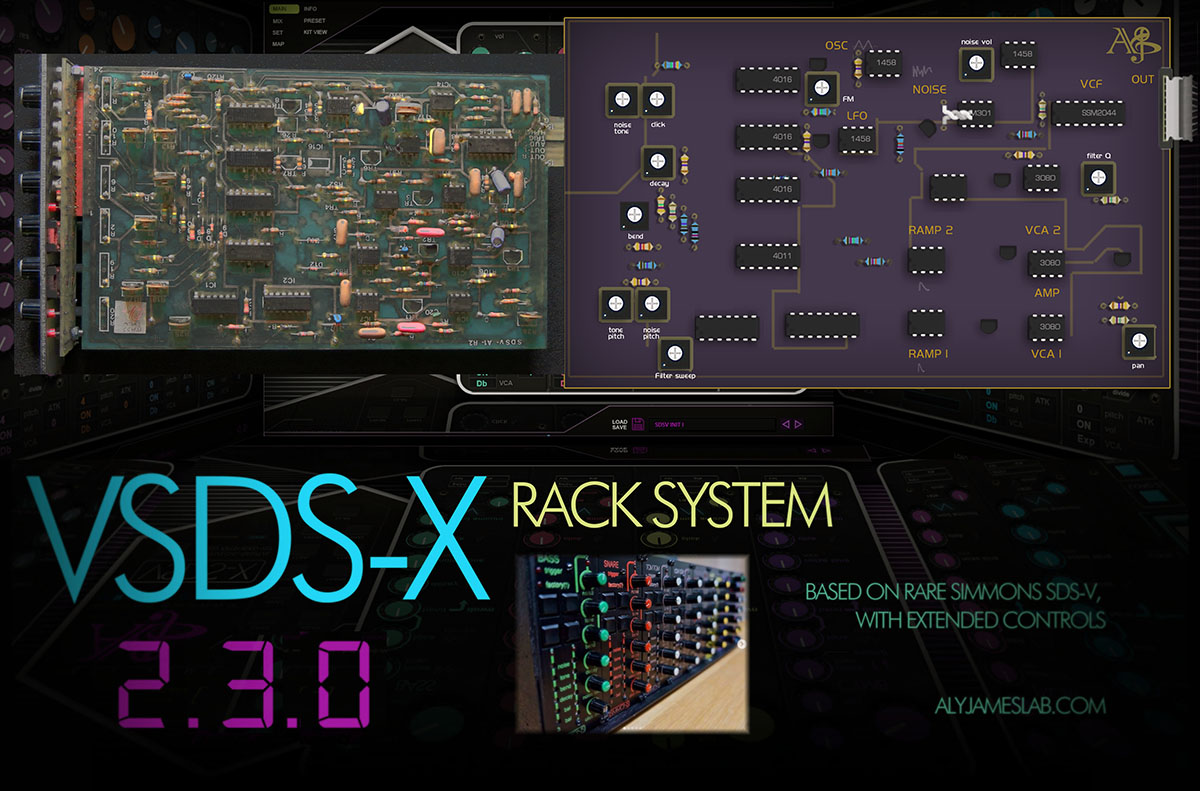
VSDSX, which stands for Virtual Simmons Drum System Extended, provides the closest experience to
the real thing, for each voice or as it was called (module) it models
accurately the analog sound generation, internal circuitry tuning, trigger velocity sensitivity and all
the details you can find explained inside the dedicated manual.
For its hybrid voices (HIHAT, CYMBAL, PROM & CLAP are a mix of analog/digital) clocks and counters
reading EPROM memory at variable sample rate are perfectly emulated in realtime.
It models the SSM2044 filters offering fine tuning control
over internal control voltages, trigger shapes, and VCA response. It also emulates how
the module will react if triggered with pads or sequencer...MIDI velocity will change the synthesized
sound drastically whether you use real drums trigger detection or piano roll style composition.
Offering multi output capability for your DAW, VSDSX will give you that
legendary powerful analog punch! On top of the cake, two voices can load your own
external EPROM image data (digital sample) like on a real SDS1 (EPROM based)
pad...offering a whole new range of sounds.
VSDSX is now on version 2.3 and features among other cool things a perfectly emulated
Simmons Digital ClapTrap module, a clap synth which combines a variable sample rate
digital source combined with pitched analog noise, an original feature of the unit was to never produce
the same sound twice. Although it is integrated inside VSDSX a dedicated ClapTrap 2.0 plugin which
includes both analog and digital models, stereo
widening,
chromatic (per note) trigger, original hardware filter, EPROM replacing capabilty and way more controls
like dual mode and analog clap generation circuit tuning is available
separately.
VSDSX provides a huge synthetic drum sound by itself and can also be used with great efficiency in drum layering. Parameters automation and modulation can turn this thing into a crazy an creative sound source
Using it for layering with VPROM can produce a nasty funky sound which combines analog and early digital!

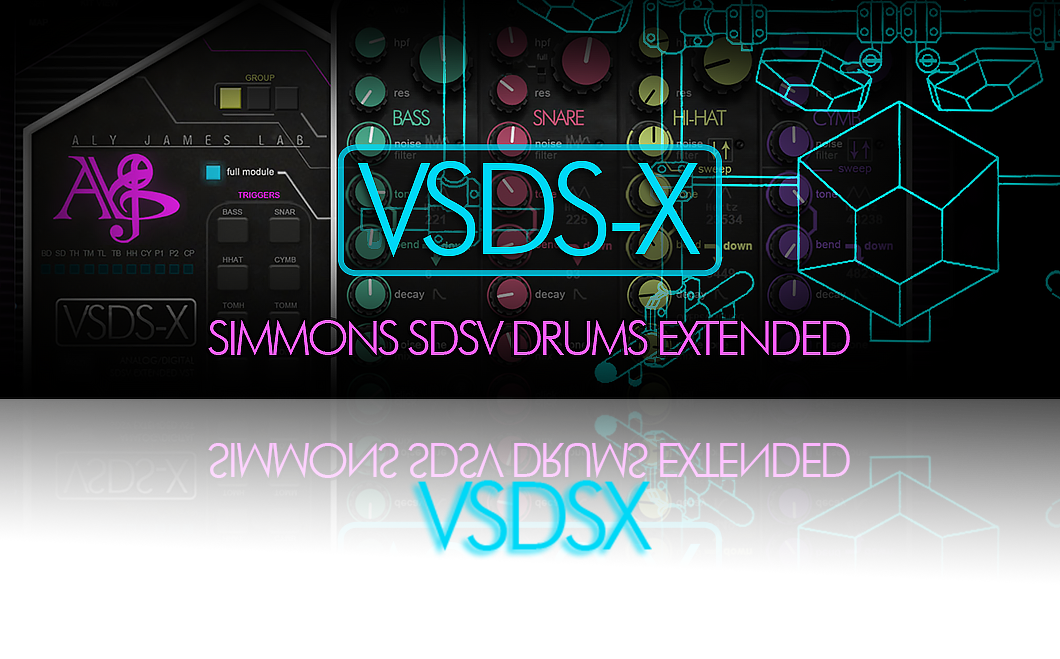
The ultimate 80s drum sound!
coming up...
The special tone character of the drum synth is mainly caused by the raw analog waveform generation and by the circuitry itself, it generates harmonics that are normally not present in an ideal triangle waveform, VSDSX emulates that behavior and also models the analog clipping that occurs when pushed hard. You can also switch to a clean mode which will behave like an ideal system without OPAMP bandwidth limitation (more highs). These features alone offer a great versatility for sound design. A custom mode can switch all oscillators from the typical Simmons shape to a Sine shape that can be used if you would need less harmonics
The sound source of the drum synth was mainly a mix between a triangle oscillator and a transistor based noise generator. The way it was initially connected could be tuned for more or less frequency content. Each voice has different configuration and VSDSX offers user control over the internal noise filtering (especially useful on the snare voice card).
A lot of the circuitry parameters can also be fine-tuned, CV and VCA response, Trigger types (that will mostly impact the click attack generator time) etc.
The noise source was filtered by an SSM2044 lowpass filter chip, the filter acts on the noise and click part and behave differently depending on the voice, on bass & toms the resonance resistor was usually set to no resonance, but this can be tweaked inside the VSDSX if you want.
One of the obvious things that must be there in a drum synthesizer is a pitch envelope to simulate the behavior of real drums. The SDSV module featured a bending down effect that can be set to more or less amount of bending. VSDSX also features a bend up option and an optional FM modulation taken from the SDS7 module, the LFO can go from very slow to audio range modulation and can be optionnaly controlled by velocity.
The VSDSX have dedicated outputs for every voice like an original SDSV + PROM and CLAP modules.
You can choose from ALL to 1 Stereo Channel or Separate Channels for each voice.
The drum synth is highly sensitive to the power of which a pad or a key is hit, VSDSX gives independent access to sensitivity tuning for each voice, the pitch of the tone, VCF cutoff, click trigger etc...You can also disable the volume velocity tracking and only set a pitch sensitivity which gives access to a similar feature than the "run generator" found in certain Simmons Systems.
The GUI features all the SDSV controls (with the same weird naming) but can also give access to a full module display with more in-depth controls, most of the parameters can be MIDI learned and controlled by an external MIDI Hardware or automation.
By default VSDSX triggers are mapped to the MIDI GM standard but you can customize it to your liking using its MIDI learning function. The map can be saved globaly and will be recalled everytime.
The VSDSX provides one voice which is based on the mighty Simmons ClapTrap (digital model MK3),
finely tuned against an
original unit it reproduce the digital circuit, EPROM looping, Human feature and pitched noise
source.
The original VCAs got something between an exponential and linear behavior useful for those
almost
gated claps, VSDSX adds a more pronounced exponential option, slightly increased tuning range on
the low side and also provides an entire dedicated plugin if you feel like clapping someone's
face
with stereo widening capability using two emulated voices running with EPROM clock and filter
offsets.
The VSDSX provides two voices which are EPROM based (like SDS1 or SDS7) the imported original
EPROM
image(sample) will benefit from the bend and noise mixing feature with that
crunchy 8bit sound.
Load your own custom made EPROM image. EPROM format is the same as VProm (U255 companded) for
easy
compatibility but it can also now load Linear PCM format(most of Simmons original EPROMS were
Linear PCM).
VSDSX supports any size EPROMS binaries (.bin) between 1K to 64K.
The Hi-hat & Cymbal modules were pretty rare and unique sounding, mostly they were
sample
based, same configuration for both cards, but in a very
particular way.
Honestly, the metallic waveform has nothing to do with a real hi-hat or cymbal sound, you
can
hear its looping and the raw 8bit character, but: This is
a CULT sound! If you play this with bending up or down while toying around with noise and
filter, you get these famous cymbal sweeps!
Velocity can also act on the sample rate and it sounds pretty original.
Memory was expensive at that time so you cannot store a long sample and be cost
effective.
So Dave Simmons looped the short sound stored onto a 2732 EPROM, a trick also used by
Roger
Linn
in the LM-1 but this time, the sample is read forward
then backward.
The loop plays all the time inside the SDSVs digital modules and only VCA and VCF are
triggered,
this configuration opens up to very long decay
settings.
The 555 Timer is the clock which set the speed of sample reading, the CD4516 are the
counters
and the CD4013 is changing the readout direction once
counter reach the end.
The data are stored as a linear 8bit format and decoded by the linear 8bit DAC.
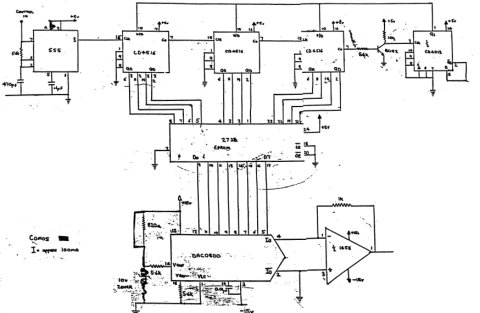
The original SDSV schematic and a lot of useful documentation found on the great
simmonsmuseum.com
website were priceless to design VSDSX.
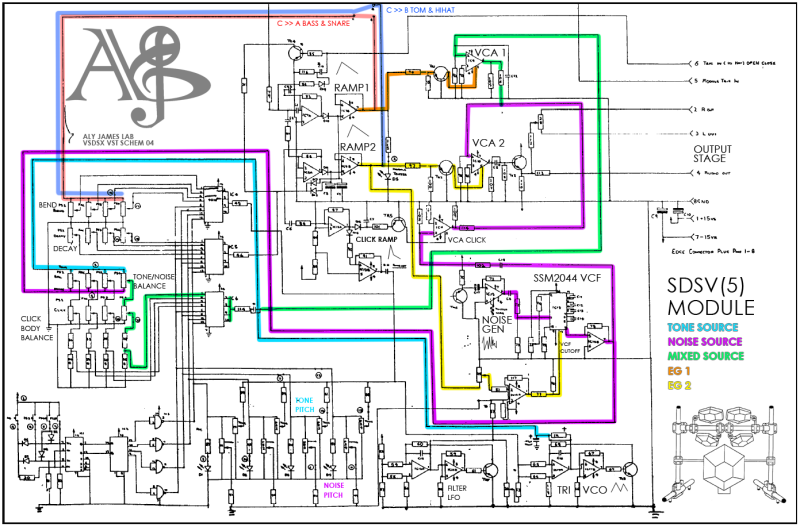
Get amazing details about the Simmons SDSV Drum Brain and master the VSDSX!
VSDSX SIMMONS DRUMS MANUAL V2.3
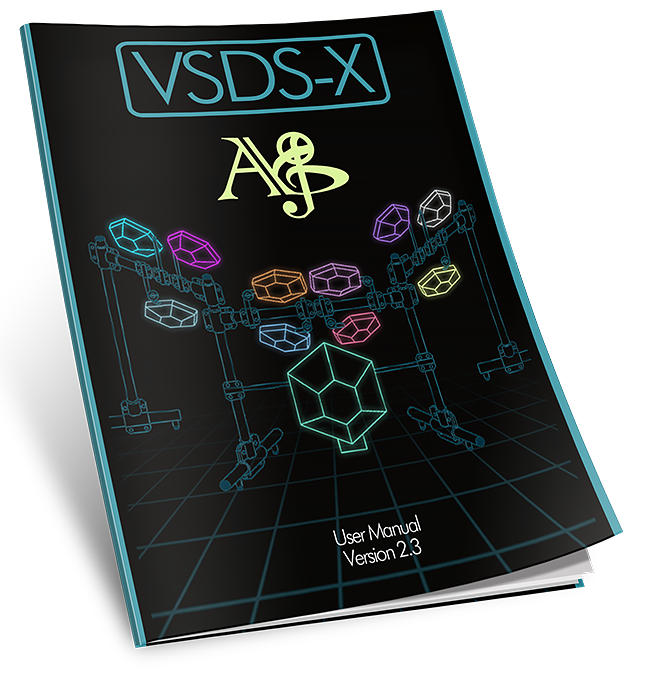
You can check your current version with a right click on the GUI.
VSDSX v2 for PC & MAC
| Machine | Format(s) | Architecture(s) | Native Processor(s) | OS Supported | Note |
|---|---|---|---|---|---|
| PC | VST3 | X64 | INTEL | Windows 10 or higher | |
| Mac | VST3, AU | X64 | INTEL/ARM | Mac OS-10.14 or higher |
VSDSX 2.3 comes with both PC & Mac Installers